“Where are we?” That’s what the 6 a.m. early-risers asked the wildlife detection crew on the bow of the National Geographic Sea Bird. We were somewhere in the mouth of Glacier Bay, having anchored the previous night for rest and reprieve. We were continuing our voyage along Icy Strait into the head of Cross Sound, which opens into the Gulf of Alaska and the North Pacific Ocean. In about 14 nautical miles, we would arrive in the Inian Islands, a seascape of massive maelstroms and eddies caused by tidal currents converging from inside the passage and outside ocean waters. The upwelling of nutrients (phosphorous and iron) are a boon to phytoplankton, the microscopic plants that are consumed by zooplankton, who in turn are eaten by newly hatched fish, who feed the larger fish, who, at last, provide nutrients to the sea lions.
The sea lions of Cross Sound are expert swimmers, and we watched in awe from our motor boats as they cavorted in the standing waves that surround the slick of water where their fish is delivered to them from hundreds of feet below the surface. Using their powerful foreflippers, they surfaced and disappeared beneath the waves, and all we could do was wonder at the magnificence of their evolutionary prowess. We realized we would surely perish if we were to attempt to enter this powerful water. To the sea lions, as well as the sea otters, puffins, cormorants, and others, the maelstroms are a paradise for feeding and engaging with each other.
South of the Inians is George Island, a retreat for us as well as the residents of the nearby fishing hamlet Elfin Cove. We spent the afternoon kayaking and riding the expedition landing crafts, walked the trails and beaches, and explored the wrack lines and tidepools (ponds left behind in depressions during the retreating tide). The spring tide rose in the afternoon as we made our way to the windward side of the island, and the small waves lapping the shore formed gigantic seas. Higher on the rocky beach in the placid tidepools, hundreds of newly hatched tidepool sculpin (Oligocottus maculosus) darted with their parents through patches of sunlight and shadow in their mini-ocean world. Fortunately for these little fish, dense forests of the green sea lettuce Entermorpha and the brown seaweed Odonthalia floccosa have gained foothold along the perimeter of the tidepool to offer protection from the ultraviolet radiation of the mid-day sun. Surely when the tide reaches the higher rocks, this family of fish will exhibit the same prowess navigating turbulent waters as the sea lions, albeit on a miniature scale.
By late afternoon, we bid farewell to George and the Inian Islands and we welcomed our evening meal. We will push onward through the night to reach our next destination, looking forward to the adventures that a new day will bring.







